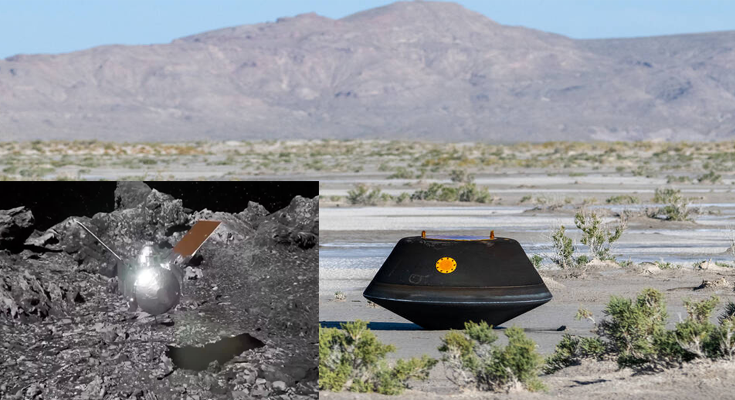JNS: In a historic and meticulously orchestrated mission that spanned several years, NASA’s OSIRIS-REx (Origins, Spectral Interpretation, Resource Identification and Security–Regolith Explorer) team has triumphantly delivered a cache of rocks and dust collected from the asteroid Bennu to Earth. This achievement marks NASA’s pioneering venture into asteroid sample return, a significant milestone in space exploration.
The long-anticipated moment transpired today as a science capsule, bearing invaluable material from the asteroid Bennu, re-entered Earth’s atmosphere. The capsule’s journey commenced from Bennu, covering a staggering distance of 1.2 billion miles.
The momentous descent of the capsule from the OSIRIS-REx spacecraft occurred during the early hours of Sunday, September 24th, travelling at an astonishing speed of approximately 27,000 mph. A pinpoint landing was achieved at 8:52 a.m. MDT (10:52 a.m. EDT) within the predefined area of the Department of Defense’s Utah Test and Training Range, located near Salt Lake City.
Within a mere ninety minutes of touchdown, the capsule was airlifted to a specialized temporary clean room, housed in a hangar on the training range. Here, it has been methodically subjected to a “nitrogen purge,” a vital procedure undertaken by scientists. The infusion of nitrogen, a chemically inert gas, into the sample container within the capsule, serves the crucial purpose of safeguarding the samples from terrestrial contaminants, preserving their purity for subsequent scientific analysis.
The return of these meticulously collected samples from Bennu holds immense scientific promise. Scientists worldwide anticipate groundbreaking discoveries that will expand our understanding of planet formation and the origins of organic matter and water, which contributed to life on Earth. Furthermore, this mission promises to enhance our knowledge of potentially hazardous asteroids, offering vital insights to protect our planet.
Expressing his elation, NASA Administrator Bill Nelson commented, “Congratulations to the OSIRIS-REx team on a picture-perfect mission – the first American asteroid sample return in history – which will deepen our understanding of the origin of our solar system and its formation.
Not to mention, Bennu is a potentially hazardous asteroid, and what we learn from the sample will help us better understand the types of asteroids that could come our way.”
The Bennu sample, estimated to weigh approximately 8.8 ounces (250 grams), will be transported in its sealed container by aircraft to NASA’s Johnson Space Center in Houston on Monday, September 25th. At this facility, curation scientists will carefully dismantle the canister, extract the sample, conduct detailed assessments of the collected rocks and dust, and eventually distribute portions of Bennu to scientists across the globe.
This achievement is a testament to the unwavering dedication of hundreds of individuals who have remotely guided the spacecraft’s journey since its launch on September 8, 2016. The mission successfully orchestrated the spacecraft’s arrival at Bennu on December 3, 2018, followed by meticulous site selection for sample collection between 2019 and 2020. The actual sample collection took place on October 20, 2020, and the spacecraft commenced its return journey on May 10, 2021.
Dante Lauretta, the principal investigator for OSIRIS-REx at the University of Arizona, Tucson, expressed the magnitude of this accomplishment, stating, “Today marks an extraordinary milestone not just for the OSIRIS-REx team but for science as a whole… We now have the unprecedented opportunity to analyze these samples and delve deeper into the secrets of our solar system.”
After traversing billions of miles to Bennu and back, the OSIRIS-REx spacecraft executed the release of its sample capsule into Earth’s atmosphere at 6:42 a.m. EDT (4:42 a.m. MDT). At that moment, the spacecraft was positioned approximately 63,000 miles (102,000 kilometres) from Earth’s surface, roughly one-third of the distance to the Moon.
Travelling at a staggering velocity of 27,650 mph (44,500 kph), the capsule breached Earth’s atmosphere at 10:42 a.m. EDT (8:42 a.m. MDT), off the California coast, at an altitude of approximately 83 miles (133 kilometers). Two parachutes were deployed en route, successfully stabilizing and slowing the capsule to a gentle 11 mph (18 kph) upon touchdown.
Rich Burns, project manager for OSIRIS-REx at NASA’s Goddard Space Flight Center in Greenbelt, Maryland, conveyed the exhilaration of the team, likening the moment to a high-pressure sports event, stating, “The whole team had butterflies today, but that’s the focused anticipation of a critical event by a well-prepared team… this team knocked it out of the park.”
A meticulous tracking system involving radar, infrared, and optical instruments both in the air and on the ground ensured the capsule’s precision landing within a designated area spanning 36 miles by 8.5 miles (58 kilometers by 14 kilometers) on the Utah Test and Training Range. In a swift response, the recovery team was dispatched to retrieve the capsule, locating it in pristine condition at 9:07 a.m. MDT (11:07 a.m. EDT). Following thorough inspection and clearance, the capsule was expeditiously transported to a temporary clean room on the range, where it remains under constant supervision and nitrogen protection.
Overall mission management, systems engineering, and safety and mission assurance for OSIRIS-REx were provided by NASA Goddard. The University of Arizona, Tucson, led the science team, along with the mission’s science observation planning and data processing. Lockheed Martin Space in Littleton, Colorado, played a pivotal role in constructing the spacecraft and continues to manage flight operations.
Navigation of the OSIRIS-REx spacecraft was a joint effort by NASA Goddard and KinetX Aerospace, while curation for OSIRIS-REx, including sample processing upon its arrival on Earth, will occur at NASA Johnson.
International collaboration was integral to the mission, with the OSIRIS-REx Laser Altimeter instrument contributed by the Canadian Space Agency (CSA) and asteroid sample science collaboration established with the Japan Aerospace Exploration Agency’s (JAXA) Hayabusa2 mission. OSIRIS-REx represents the third mission within NASA’s New Frontiers Program, overseen by NASA’s Marshall Space Flight Center in Huntsville, Alabama, on behalf of the agency’s Science Mission Directorate in Washington.




